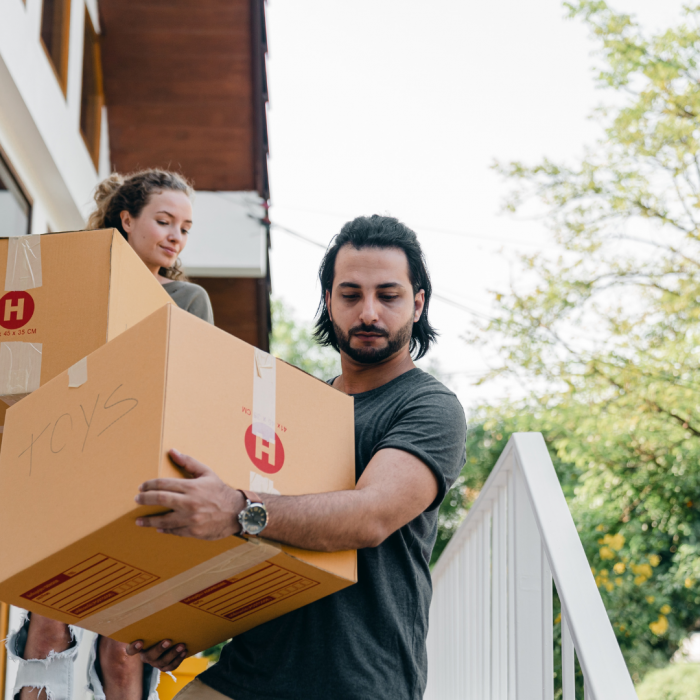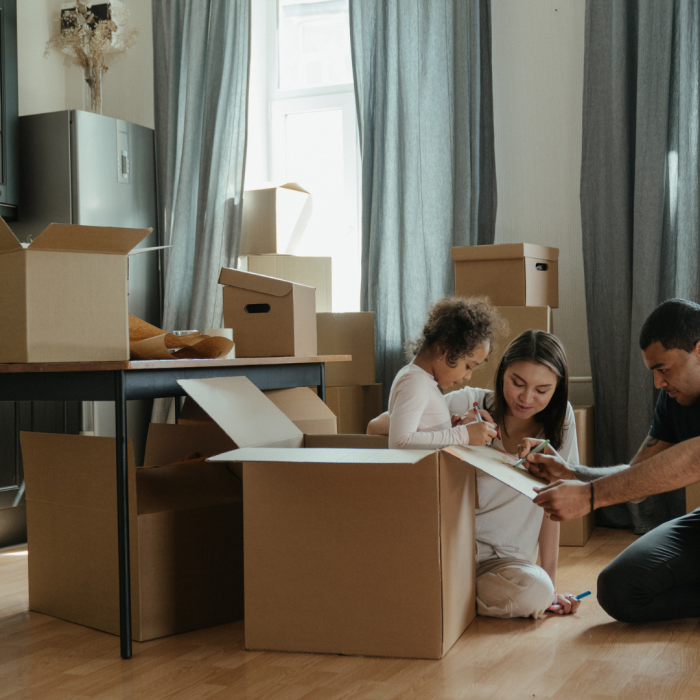
The Ultimate Apartment Moving Guide: Your Step-by-Step Plan
March 31, 2025 7:08 pm Leave your thoughtsMoving to a new apartment is exciting but can also be overwhelming. Whether it’s your first move or you’ve done this before, there are always a few things to consider. You may need to condense your belongings further or organize them differently. From packing to settling into your new space, this guide will help you stay organized and make the process less stressful.
Start Early! The Key to a Smooth Move
The earlier you start preparing for your move, the easier it will be. When you begin early, you have more time to think through all the details, which helps you avoid feeling rushed or overwhelmed. It can also help you make the proper arrangements before the big moving day arrives. Follow the two steps below to ensure you’re ready for your new space!
Set a Moving Date: The first step is to figure out exactly when you’ll be moving. It’s important to lock down the date early, and it’s a good idea to secure your apartment and set your moving day at least 6-8 weeks in advance. That way, you’ll have enough time to get everything ready without last-minute panic.
It also lets you know any last-minute details about the property you’re investing in. The leasing agents may provide you with any remaining items they need, and then will finalize the date that you can move in.
Create a Moving Timeline: Once you know your moving date, break everything down into smaller tasks and checklists. If you spread out the tasks over several weeks, it’ll be much easier to stay on top of everything and avoid feeling overwhelmed. You can also ask those around you for help so you don’t have to go at it all alone!
Budgeting for a Move: Budgeting involves more than saving for rent and boxes. Be sure to include hidden costs like elevator reservation fees, cleaning charges for your old place, pet deposits, and setup fees for internet or utilities. If you’re moving to another city, gas, tolls, and hotel stays can raise your total cost.
Create a moving budget using a free spreadsheet tool or budgeting app. List all your expected costs and leave a 10 to 15 percent cushion for surprise expenses. If money is tight, try saving by borrowing boxes from local stores, moving on a weekday for lower rates, or asking friends to help instead of hiring movers.
Lease Agreement Checklist: Double-check a few key things before signing the lease. Make sure pets are allowed and ask about extra pet fees. Watch out for hidden costs like parking or trash removal fees. Do a move-in inspection with the landlord to note any damage. Also, clarify how long the lease lasts, the renewal process, and who covers utilities like water and electricity. Before signing a lease, take time to go over all rental terms so you don’t get stuck with surprise fees or hidden costs.
Before moving in, take clear photos or videos of each room, especially spots with scratches, stains, or dents. These photos can help if there are questions about your security deposit or who caused damage. Save copies to your email or cloud storage so you don’t lose them.

Hire Professional Movers vs. DIY Move
You have two main options for moving: hire professional movers or do it yourself. Each choice has its pros and cons, so it’s essential to consider factors like your budget, how much furniture you have, and how much time you can dedicate to the process.
Hiring movers can make your move much easier since the professionals handle almost everything. They’ll pack your things, disassemble furniture, and even unpack at your new place. This is an excellent option if you have heavy or fragile items or are short on time. However, it can be expensive, ranging from $300 to $1,500, depending on how much help you need and how far you are.
Your location, service level, and distance can affect its cost. If you can afford it and want a stress-free move, hiring movers can save you a lot of hassle. When choosing a mover, vet companies by reading reviews, asking for recommendations, and verifying their credentials to avoid scams and ensure a smooth, reliable experience.
On the other hand, if you choose a DIY move, it’s usually much cheaper, but it comes with more work. You’ll rent a truck, recruit friends to help you with the heavy lifting, and handle the packing and unloading yourself. While this can save you money, it’s also more physically demanding, so ensure you’re prepared. Additionally, you’ll choose the right truck size to avoid extra trips.
If you decide to go the DIY route, booking your rental truck early is crucial. This is especially important during busy moving seasons, such as the summer or at the end of the month, when many leases are up. If you wait too long, you might find that all the trucks are booked, leaving you scrambling for alternatives. Planning can help ensure that everything goes smoothly and on time.
Organize and Declutter Your Belongings
One of the best things about moving is the chance to declutter. Before packing, review your stuff and remove things you no longer use or need. This will not only make your move more manageable, but it will also help you feel more organized and fresh in your new place.
- Sort Your Items: Walk through each room and decide what to keep, sell, donate, or toss. If you haven’t used something in a year, it’s probably time to let it go. However, if it’s sentimental or brings you joy, find a safe place to pack it. You can consider sorting your items using the Marie Kondo “Spark Joy” method.
- Sell Unwanted Items: If you have things in good condition, consider having a yard sale or selling items online. It’s a great way to make some extra while eliminating things you don’t need. Donating clothes or furniture to charity is also an excellent way to give back to the community.
- Digitize Paperwork: Old paperwork can pile up fast. Instead of packing all that paper, please take a few hours to scan and store important documents digitally. This will help you free up space and keep your new place clutter-free.
- Donate Unused Furniture: If you have old furniture you don’t want to bring to your new place, consider donating it to a local shelter or charity. It will help someone in need and save you the hassle of moving bulky items.
- Moving With Pets: When moving with pets, plan ahead to help reduce their stress. Keep their favorite toys or bedding close during the move, and make sure their ID tags have your new address. Let them get used to one room before giving them access to the whole apartment. It helps them feel safer in their new place.
- Tackle Your Closet: Go through your closet and sort out the clothes you haven’t worn. Donate or sell anything that’s not in good condition, and toss out anything worn. A clean closet will make packing and organizing easier.
- Get Rid of Excess Packing Supplies: If you have any old boxes, bubble wrap, or packing materials that you don’t plan to use, consider recycling or reusing them. It will help reduce waste and also lighten your load.

Gather Packing Supplies
Once you’ve cleared out the clutter, it’s time to gather your packing supplies. Having everything you need ahead of time makes the move smoother and keeps your things safe! Don’t make the mistake of not correctly packing and risking your non-essential items getting damaged during the move.
Boxes: Use a mix of small and large boxes. Smaller ones are ideal for books and fragile items, while bigger boxes are great for clothes, bedding, and other lightweight things.
Packing Tape & Bubble Wrap: Strong packing tape is essential to seal boxes, and bubble wrap is crucial for protecting fragile items like glassware or electronics.
Markers & Labels: Label each box with its contents and the room to which it belongs. This makes unpacking smoother and keeps things organized.
Furniture Covers: Protect larger furniture like sofas or dressers with covers to prevent scratches and dirt. Old blankets can work in a pinch.
Packing Peanuts or Foam: Use these for extra cushioning when packing delicate items to prevent shifting during the move.
Stretch Wrap: Ideal for securing items like kitchenware or wrapping up drawers to keep them closed during transport.
Moving Blankets: For larger furniture or appliances, moving blankets add padding to prevent damage during the move.
You can find packing supplies at moving companies, storage facilities, or even ask around at local stores for free boxes.
Grocery stores, bookstores, and liquor stores often have sturdy boxes they’ll give away. Check local online groups or community boards where people post free moving supplies. Many neighborhoods have social media groups where people give away packing materials after they move.
Notify Your Landlord and Utilities
Before leaving your old place, take care of a few essential tasks to ensure a smooth transition. Handling these details will save you from scrambling at the last minute.
Inform Your Landlord: To get your security deposit back, inform your landlord of your move-out date and follow any move-out procedures.
Manage Utilities: Schedule disconnection for your old apartment and connection for your new one. Remember trash pickup, internet, and cable.
Submit a Change of Address: Visit the post office and fill out a change-of-address form to update your address for banks, credit cards, and subscriptions.
Update Insurance: Update your renters’ insurance to reflect your new address and ensure you’re insured.
Schedule a Move-Out Inspection: Schedule a walk-through with your landlord and address any cleaning or repairs before the inspection.
Return Keys and Parking Permits: On your last day, return all keys, garage openers, and access cards to your landlord.
Moving Day Tips
The big day is here! Whether moving on your own or working with movers, you can do a few things to make the process run as smoothly as possible. Here’s a helpful list to keep you on track:
Take Breaks
Moving is physically demanding, especially if you do it yourself. It’s essential to take breaks regularly to avoid overexerting yourself. Sit down, take a few deep breaths, and drink plenty of water to stay hydrated. Moving is a marathon, not a sprint, so pacing yourself will help you keep your energy up throughout the day.
Inspect Your New Apartment
Before unpacking or settling in, quickly walk through your new apartment. Look for any damages or issues that might need attention, like scratched floors, broken appliances, or leaky faucets. Taking note of these things early will allow you to address them immediately, and you can report any damages to your landlord or management company.
Give Clear Instructions to Movers
If you’ve hired movers, provide them with clear instructions on where you’ve placed each item in your new home. For example, tell them which room the couch goes in, where the dining table should be, and where to stack all the boxes. This will save you time later and ensure that everything is in the right spot when you start unpacking.
Don’t Forget to Tip Your Movers
If you’re using a professional, remember to appreciate their hard work. A tip of 10-15% of the total moving cost is a good guideline, but feel free to adjust based on your satisfaction with their service.
First Night Essentials Box: Pack a box with things you’ll need immediately! Include toiletries (toothbrush, soap, toothpaste), phone chargers, snacks, and a pillow and blanket for bed. Add basic cleaning supplies and any meds you need. This box will make your first night much smoother and more comfortable.
Pack a small first aid kit with band-aids, pain relievers, and daily medications. A flashlight and extra batteries are helpful if the power goes out. Keep emergency contact info in your phone and write it down in case you can’t access your device.

Settling In and Unpacking
Congratulations, you’ve made it to your new apartment! Now, the hard work is behind you, and it’s time for the fun part: unpacking and making your new space fit like home. The key here is to take your time and focus on getting everything in its place, so you feel comfortable and settled.
Most people need about 1 to 2 weeks to unpack, based on their work schedules and how much help they get. Start with the kitchen and bedroom, and unpack one room at a time to make the process easier. Add warm lighting, wall art, or familiar scents to make your space feel cozy right away. Set up a speaker or display your favorite decor early so the space feels more like home.
Start with the essentials. You’ll need these items immediately, like toiletries, kitchen supplies, and bedding. Having these basics on hand will make your apartment feel livable immediately, and it’ll take some of the pressure off while you tackle the rest of it. You don’t want to be stuck scrambling for your toothbrush or a pot to don’t in when you’ve just moved in, so focusing on these things first will help you breathe a little easier.
Next, it’s time to set up your space. Arrange your furniture and decor so that your apartment reflects your style. This is your chance to create a place to feel relaxed and happy, so take your time with it. Don’t rush; move it around if you don’t like how something looks. Plus, rearranging furniture can be fun!
Ask your landlord if you can change the locks for added security. Check with your landlord before doing this, as it may not be allowed.
Before you know it, your new apartment will feel organized, cozy, and just like home. It’s all about setting up your space to work for you, and getting everything unpacked in a way that makes life easier.
Now, enjoy your new apartment!
Moving into a new apartment doesn’t have to be stressful. With some planning, patience, and adoesn’t, you’ll be settled in before you know it. Take things one step at a time, start with the essentials, and don’t rush the process of making your space feel like your own. Remember that you don’t have to do it all at once, and asking for help is okay. Moving is a fresh start, a new chapter, and a chance to create a living space that suits you.
Still looking for the right apartment?
Categorised in: Apartment Living
This post was written by Isabella Housel
Isabella Housel is a passionate and versatile professional writer with a deep love for words and a commitment to crafting compelling content that engages, informs, and inspires. With many years of experience in the industry, she has honed her skills across various genres, from creative storytelling to informative articles and technical documentation.




